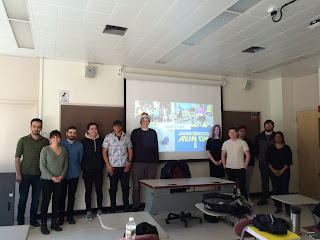Having expert practitioners speak to students in my Humanitarian Logistics and Healthcare class provides outstanding educational experiences that stay with students even after they graduate. The logistics of scheduling experts can, in itself, be challenging, but the risks reap great rewards.
This past Tuesday, we had the honor of hosting Ms. Sara Zalieckas, who is an All Hazards Planner with MEMA (Massachusetts Emergency Management Agency) and is based in Framingham, Massachusetts (about a two hour drive to UMass Amherst). She arrived in time for the early morning class, which meets from 8:30AM-9:45AM and, although I was waiting for her in the original atrium to escort her to the classroom, and she was in the new $62million addition to the Isenberg School, we connected in time!
Ms Zalieckas is a Canadian, which made me extra excited since I was also born in Canada, and, in fact, had been to Halifax last summer to present at the CORS (Canadian Operations Research Society) conference, where she is from! She has worked for MEMA since 2012 and, hence, was employed by MEMA, when the bombing at the Boston Marathon took place on April 15, 2013.
The title of her guest lecture was: The Boston Marathon - Public Safety and Security Experience.
This year's Boston Marathon is taking place on April 15, 2019.
Ms. Zalieckas informed us of the extensive planning involved among multiple organizations to ensure the safety and security of runners, volunteers, supporters, and spectators alike in this major sports event, which covers over 26 miles (I have run several Ocean State marathons in RI, so I understand the energy and athleticism involved). It is considered the most challenging sports event to secure in the country. The Super Bowl is in one location, in contrast, for example. In 2013, there were 27,000 registered runners and the weather was ideal. In 2019, 60,000 runners are expected.
Rather than detailing the horrific attacks at the 2013 Boston Marathon, I will refer you to a blogpost I wrote following the guest lecture of Dr. Pierre Rouzier, who is a sports medicine physician, based at UMass Amherst, and who was working in a triage tent at that Marathon.
Post 2013, the focus has been on lessons learned, and on assessing vulnerabilities and threats. Ms. Zalieckas brought to our attention, the 2013 Boston Marathon after action report, which can be accessed here.
Previously, jurisdictions had been working in silos, which was understandable since the marathon course covers a distance of over 26 miles. Now there is a Unified Coordination Plan, with plans for evacuations, should the need arise, along the course in multiple locations, with even alternative routes to shelters along the Boston Marathon route identified, along with transportation options, such as buses staged. This I found truly fascinating. Now there is a joint information center and system, so that rumors, which are unsubstantiated, do not propagate, along with misinformation. There are also station "blocking" vehicles along the course.
The level of detail and the organizations involved to ensure public safety and security is extraordinary. More intense planning has been taking place since January 2019 to test out communications, to run tabletop exercises and training, to conduct intelligence and investigations (with appropriate federal partners), and to also address how to respond to mass casualty events. I also found it very impressive that MEMA, along with partners, has structured coordination of decision making and there is now a Unified Coordination Center. You may know that the MEMA headquarters in Framingham is actually an underground bunker built during the Cold War and our President at that time, John F. Kennedy, was to inaugurate its opening, but he was assassinated.
It is also so impressive that there is!a drone response plan is in place for the Boston Marathon and, of course, GIS is also utilized to monitor congestion along the route.
Ms. Sara Zaieckas' guest lecture was mesmerizing. I also was very pleased that we had a female speaker this term (and will be having another one next month).
We took a group photo after her guest lecture.
In appreciation, we presented Ms. Zalieckas with a gift from the Isenberg School of Management, and I followed up with several photos and a formal thank you letter, which I also copied to the new Director of MEMA, Ms. Samantha Phillips, which was recently appointed to this important most by Governor Charlie Baker. Quite exciting to have a female at the helm of MEMA!
I wish all the runners, the volunteers, supporters, and spectators, as well as the emergency management folks and their liaisons, a wonderful and safe 2019 Boston Marathon! We will be watching and cheering from near and far!
About Me
- Dr. Anna Nagurney
- Dr. Anna Nagurney is the Eugene M. Isenberg Chair in Integrative Studies at the Isenberg School of Management at the University of Massachusetts Amherst. She was appointed to this chaired professorship on April 14, 2021. Prior to this chaired professorship, since 1998, she was the John F. Smith Memorial Professor of Operations Management. She is the Founding Director of the Virtual Center for Supernetworks, which she established in 2001. Professor Nagurney has held positions at Harvard, MIT, Brown University, Oxford University, the Royal Institute of Technology (KTH), the University of Gothenburg, and the University of Innsbruck. She is the author/co-author of over 235 journal articles and over a dozen books. Nagurney is regularly sought out by major media outlets because of her expertise on supply chains and networks systems plus policies. She has given many keynote and other invited talks internationally.





















